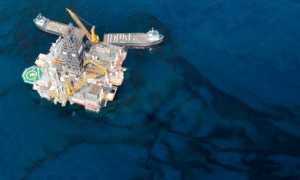http://www.guardian.co.uk/environment/2010/may/31/bp-oil-spill-death-impact
It could take months or years for the true impact of the spill on surrounding ecosystems to emerge
by David Adam and agencies
guardian.co.uk, Monday 31 May 2010 23.14 BST
The White House says the BP oil spill is probably the greatest environmental disaster the US has faced, but the true impact on surrounding ecosystems could take months or even years to emerge. Experts say the unprecedented depth of the spill, combined with the use of chemicals that broke the oil down before it reached the surface, pose an unknown threat.
Oil floats around a rig at the site of the Deepwater Horizon oil spill in the Gulf of Mexico. Photograph: Jae C. Hong/AP
“It’s difficult to marshal resources to do a thorough job of charting what the impacts are,” Jeffrey Short, an environmental chemist who worked on the effects of the Exxon Valdez spill, told Nature magazine. “It’s especially difficult when weird things happen to catch the scientific community bysurprise. That’s clearly the case here.”
Louisiana, the nearest state to the leaking well, some 42 miles offshore, has been the most impacted. The state’s governor, Bobby Jindal, said more than 100 miles of its 400-mile coast had so far been polluted.
State officials have reported sheets of oil soiling wetlands and seeping into marine and bird nurseries, leaving a stain of sticky crude on cane that binds the marshes together. Billy Nungesser, president of Plaquemines parish, said he had seen dying cane and “no life” in parts of Pass-a-Loutre wildlife refuge.
Oil debris, in the form of tar balls and surface sheen, has also been reported ashore in outlying parts of coastal Mississippi and Alabama. Tar balls found on Florida beaches a fortnight ago did not come from the BP spill, tests showed.
A quarter of US waters in the Gulf of Mexico are closed to fishing, hitting the livelihoods of shrimpers, oyster-catchers and charter boat operators. “Every fish and invertebrate contacting the oil is probably dying. I have no doubt about that,” said Prosanta Chakrabarty, a Louisiana State University fish biologist.
In the six weeks since the explosion that killed 11 workers and started the leak, wildlife officials say at least 491 birds, 227 turtles and 27 mammals, including dolphins, have been found dead along the US Gulf coast. Many of these were not related to the spill; only 28 of the dead birds were covered in oil. More marine creatures, including birds and mammals will be affected by surface oil, and scientists are also concerned about possible underwater clouds of dispersed oil.
Researchers say they have found at least two sprawling underwater plumes of what appear to be oil or oil derivatives, each hundreds of metres deep and stretching for miles. A plume reported last week by a team from the University of South Florida was headed toward the continental shelf off the Alabama coastline, waters thick with fish and other marine life.
No major fish kills have yet been reported, but federal officials said the impacts could take years to unfold. “This is just a giant experiment going on and we’re trying to understand scientifically what this means,” said Roger Helm, a senior official with the US Fish and Wildlife Service.
David Hollander, an oceanographer at the University of South Florida who helped discover one of the plumes, said: “It may be due to the application of the dispersants that a portion of the petroleum has extracted itself from the crude and is now incorporated into the waters with solvents and detergents.”
He said there could be knock-on impacts on organisms further up the food chain. “We think there could be both short-term and long-term implications.”
Special thanks to Richard Charter
